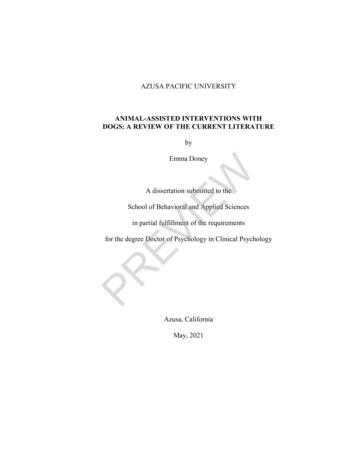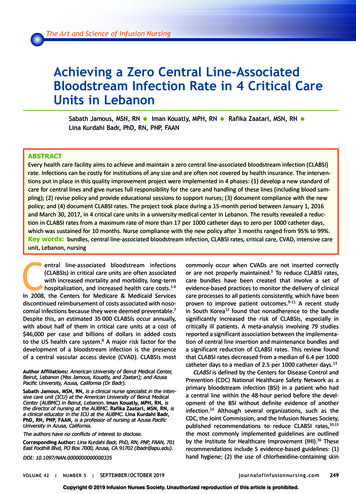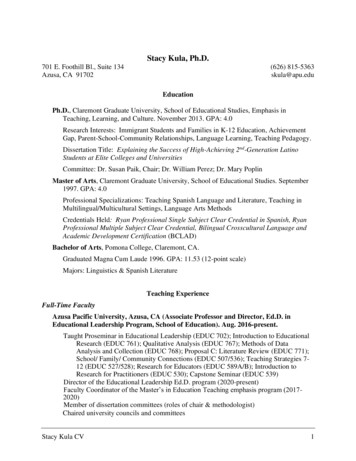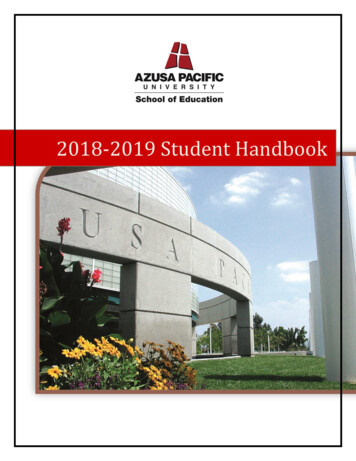
Transcription
AZUSA PACIFIC UNIVERSITYANIMAL-ASSISTED INTERVENTIONS WITHDOGS: A REVIEW OF THE CURRENT LITERATUREbyWEmma DoneyEVIEA dissertation submitted to theSchool of Behavioral and Applied Sciencesin partial fulfillment of the requirementsPRfor the degree Doctor of Psychology in Clinical PsychologyAzusa, CaliforniaMay, 2021
ProQuest Number: 28157489All rights reservedINFORMATION TO ALL USERSThe quality of this reproduction is dependent on the quality of the copy submitted.EVIEWIn the unlikely event that the author did not send a complete manuscriptand there are missing pages, these will be noted. Also, if material had to be removed,a note will indicate the deletion.ProQuest 28157489Published by ProQuest LLC ( 2020 ). Copyright of the Dissertation is held by the Author.PRAll Rights Reserved.This work is protected against unauthorized copying under Title 17, United States CodeMicroform Edition ProQuest LLC.ProQuest LLC789 East Eisenhower ParkwayP.O. Box 1346Ann Arbor, MI 48106 - 1346
2AZUSA PACIFIC UNIVERSITYANIMAL-ASSISTED INTERVENTIONS WITHDOGS: A REVIEW OF THE CURRENT LITERATUREbyEmma Doneyhas been approved by theWSchool of Behavioral and Applied Sciencesin partial fulfillment of the requirementsEVIEfor the degree Doctor of Psychology in Clinical PsychologyCOMMITTEE MEMBERSPRHolli Eaton, Psy.D., Committee ChairJoy Bustrum, Psy.D., Committee MemberACCEPTED BYRobert K. Welsh, Ph.D., ABPP, Dean, School of Behavioral and Applied Sciences
PREVIEW3 Copyright by Emma Doney 2020All Rights Reserved
4DEDICATIONI wish to dedicate this dissertation to all of the humans and non-humans who havePREVIEWloved, supported, and helped me along the way.
5ABSTRACTThe purpose of this paper was to conduct a systematic literature review of the currentstate of research on animal-assisted interventions (AAIs) in ten distinct clinicalpopulations, identify gaps in the literature, and discuss future directions. This literaturereview was conducted from January 2018 to December 2019. Databases searchedincluded: Academic Search Premier, APA PsycArticles, APA PsycExtra, APA PsycInfo,Health and Psychosocial Instruments, Health Source: Nursing/Academic Edition,Military & Government Collection, and MEDLINE. Ten distinct clinical populationsWwere assessed: children with autism spectrum disorder (ASD), children with a history ofEVIEsexual abuse, college students, medical settings, older adults in long-term care livingfacilities, prison inmates, adults with posttraumatic stress disorder (PTSD), educationalsettings, severe psychiatric population, and individuals with substance usedisorders. Articles were included if they represented an original research study, werewritten in the English language, and focused on AAIs utilizing a dog. To broaden results,PRcase studies and studies with small sample sizes were included. A total of 78 articles thatmet inclusion criteria were found. Results indicated that AAIs appeared to be effectiveand feasible programs. Methodological issues such as small sample size, inability to runrandomized controlled trials, and length of intervention were noted as barriers toresearch. Animal-assisted interventions are rapidly increasing in the United States andaround the world. Current research has shown that AAIs are an effective means foraugmenting current therapeutic practices. However, there appears to be several gaps inthe literature. Development of new methodological practices to study AAIs, exploring the
6experience of the dog involved, and understanding of culture all warrant furtherinvestigation.Keywords: animal-assisted interventions, animal-assisted therapy, companionPREVIEWanimal, dog-assisted intervention, dog-assisted therapy, pet therapy
7TABLE OF CONTENTSDedication .4Abstract .5List of Tables .91. Background .10The Human-Dog Relationship .10The Therapeutic Use of Dogs .10History.10WTerminology.14EVIEResearch .18Theoretical Foundations.22Attachment Theory .22Social/Relational Theories .23Anthropomorphism .23PRBiophilia .24Biological Processes .24Ethical Considerations .252. Literature Review.29Methods.29Children with Autism Spectrum Disorder .29Children with a History of Sexual Abuse .33College Students .35Medical Settings.39
8Older Adults in Long-Term Care Facilities .42Prison Inmates .43Posttraumatic Stress Disorder .45Educational Settings.49Severe Psychopathology .52Substance Use .543. Future Directions and Conclusion .56Research Design.56WPerspective of the Dog .57EVIECulture .57Conclusion .58References .59PRAppendix A: Tables .79
9LIST OF TABLESTable 1: AAIs and Children with ASD .31Table 2: AAIs and Children with a History of Substance Abuse .34Table 3: AAIs and College Students .37Table 4: AAIs and Prison Inmates .44Table 5: AAIs and PTSD .47Table 6: AAIs and Educational Settings .51Table 7: AAIs and Severe Psychopathology .53WTable 8: AAIs and Substance Use .55EVIETable 9: AAIs and Medical Settings .79PRTable 5: AAIs and Older Adults in Long-Term Care Living Facilities .85
10CHAPTER 1BACKGROUNDThe Human-Dog RelationshipDogs and humans have coexisted for millennia (Calcaterra et al., 2015; Furst,2015; Hosey & Melfi, 2014; Knight & Herzog, 2009; Netting et al., 1987). Archeologicalevidence strongly suggests that wolves began to evolve into domesticated dogs alongsidehumans as early as 14,000 years ago, and have played a significant role in theevolutionary development of the human species (Glenk, 2017; Krol, 2012; Mims &WWaddell, 2016; Montolio & Sancho-Pelluz, 2019; Prato-Previde et al., 2003; Silva &EVIEOsório, 2018; Solomon, 2010; Stahl, 2016; Viviers, 2014; Walsh, 2009). Since thebeginning of this symbiotic relationship, dogs have been a source of food, partners forhunting and herding, and providers of protection and companionship (Calcaterra et al.,2015; Chu et al., 2009; Furst, 2015; Glenk, 2017; Koukourikos et al., 2019; Krol, 2012;Montolio & Sancho-Pelluz, 2019; Parenti et al., 2013; Silva & Osório, 2018; Thomas &PRMatusitz, 2016; Turner, 2007; Viviers, 2014; Walsh, 2009).The Therapeutic Use of DogsHistoryThe therapeutic power of dogs has been recognized for centuries. Ancientcivilizations, such as the Greeks and the Romans, bred dogs purely for the purpose ofcompanionship (Cooley & Barker, 2018; Mims & Waddell, 2016). In the 9th century,domestic animals in Belgium were provided to disabled members of the community in aneffort to provide comfort and social support (Shubert, 2012). In the late 1600s,philosopher John Locke wrote about the beneficial impact of animals on children. He
11proposed that close interaction with small animals would help children foster empathy,explore their feelings, and develop a sense of responsibility (Compitus, 2019; le Roux &Kemp, 2009).According to anecdotal reports, animals have been utilized in Western physicaland mental medical care since the early 18th century (Chu et al., 2009; McCune et al.,2017; Stevens et al., 2017). Small domesticated animals were housed in hospitals, to becared for by patients, in an effort to increase socialization among residents (Chu et al.,2009; Mims & Waddell, 2016; Stevens et al., 2017). The first documented instance ofWthis type of treatment occurred in 1792 at a Quaker-founded inpatient psychiatric hospitalEVIEin England. The founder of York Retreat, William Tuke, advocated for the integration ofanimals into treatment plans with the purpose of cultivating a sense of humanity andaccomplishment among the patients (Chitic et al., 2012; Chu et al., 2009; Compitus,2019; Jenkins et al., 2014; Macauley, 2006; Mims & Waddell, 2016; Montolio &Sancho-Pelluz, 2019; Netting et al., 1987; Parshall, 2003; Shubert, 2012; Turner, 2007;PRVrbanac et al., 2013).Florence Nightingale, an important and influential figure in the field of nursing,documented her observations of animal interactions with physically wounded patients(Chu et al., 2009; Cruz-Fierro et al., 2019; Macauley, 2006). Her writings depicted smallcompanion animals engaged in social interaction with injured soldiers and note thehealing benefits of these exchanges (Compitus, 2019; Chu et al., 2009; Goddard &Gilmer, 2015; le Roux & Kemp, 2009; Macauley, 2006; Mims & Waddell, 2016; Stevenset al., 2017). Often she perceived increased mental and physical functioning after apatient engaged in an animal encounter (Chu et al., 2009).
12Throughout the 17th, 18th, and 19th centuries, numerous efforts were made toinvolve animals in informal therapeutic practices such as the ones mentioned above(Hosey & Melfi, 2014; Parshall, 2003). In the 20th century, formal programs began todevelop and animals were incorporated into numerous healthcare interventions(Macauley, 2006; Malamud, 2013; Parenti et al., 2013; Shubert, 2012). In 1919, theprocess of providing daily care for dogs was assimilated into the everyday routine forveterans receiving psychiatric care at St. Elizabeth’s Hospital in Washington, D.C. (Becket al., 2012; Chu et al., 2009; Macauley, 2006; Thomas & Matusitz, 2016). In the earlyW1940s, the Army Air Corps Convalescent Hospital in Pawling, New York instituted aEVIEformal animal therapy program. Veterans recovering from service-related injuriesperformed basic chores related to the care of farm animals and teaching dog obedience(Chumley, 2012; Netting et al., 1987; Shubert, 2012; Thomas & Matusitz, 2016). Theseactivities provided patients with a source of physical activity, a sense of comfort, and ameans of empowerment (Chumley, 2012; Parshall, 2003; Shubert, 2012).PRThe presence of a dog in individual psychotherapy dates back to one of the mostfamous psychotherapists, Dr. Sigmund Freud. Although many details of Dr. SigmundFreud’s work are widely known, his recognition of the therapeutic benefits of dogs is not.Freud noted that he first brought his chow chow, Jo-Fi, into sessions to help alleviatesome of Freud’s own anxiety. He soon found that the dog appeared able to pick up on thepatients’ energy. Jo-Fi provided a calming presence that Freud believed helped tofacilitate patient disclosure and speed up treatment progression (Compitus, 2019;Goddard & Gilmer, 2015).
13Child psychologist Dr. Boris Levinson is widely credited with identifying thetherapeutic benefits of dogs and incorporating dogs into individual psychotherapysessions (Aoki et al., 2012; Chu et al., 2009; Compitus, 2019; Crossman, 2017; Evans &Gray, 2012; Friesen, 2010; Goddard & Gilmer, 2015; le Roux & Kemp, 2009; Muela etal., 2017; Rossetti & King, 2010). Levinson first began to explore this concept in the1960s, when he accidentally discovered that his dog, Jingles, had a profound impact onhelping an extremely withdrawn and resistant patient open up in treatment (Chu et al.,2009; Compitus, 2019; Goddard & Gilmer, 2015; Jenkins et al., 2014; Krause-Parello &WGulick, 2015; le Roux et al., 2014; Netting et al., 1987; Parshall, 2003; Shubert, 2012).EVIEAs the child became more engaged in sessions, Levinson theorized that Jingles helped tofacilitate the therapeutic relationship and provided a sense of comfort to the patient(Berry et al., 2013; Chitic et al., 2012; Chu et al., 2009; Crossman, 2017; Cruz-Fierro etal., 2019; Goddard & Gilmer, 2015; Krause-Parello & Gulick, 2015; le Roux & Kemp,2009; Macauley, 2006; Moretti et al., 2011; Turner, 2007; Vrbanac et al., 2013). BasedPRon the idea that Jingles acted as a social lubricant, Levinson went on to conduct therapyalongside his canine partner for many years (Cruz-Fierro et al., 2019; Evans & Gray,2012; Friesen, 2010; Goddard & Gilmer, 2015; Krause-Parello & Gulick, 2015;Macauley, 2006; Rossetti & King, 2010; le Roux & Kemp, 2009; Moretti et al., 2011;Muela et al., 2017; Vrbanac et al., 2013). His published works, depicting the integrationof his dog into therapy, faced heavy criticism from the psychological community(Chumley, 2012; Crossman, 2017; Hines, 2003; Muela et al., 2017; Shubert, 2012).Despite the resistance from his peers, Levinson continued to advocate for utilization ofthis intervention. His efforts led to the development of a body of research, and current
14practices of animal-assisted therapy (AAT) have developed from the techniques thatLevinson devised and promoted (Compitus, 2019; Turner, 2007). Since the turn of the21st century, the volume of literature exploring the integration of dogs into therapeuticinterventions has steadily increased. Dogs have been effectively utilized with childrenand adults in a variety of settings, under the direction of volunteers and mental healthprofessionals (Cooley & Barker, 2018; Dietz et al., 2012; Phelps et al., 2008; le Roux &Kemp, 2009).TerminologyWOverviewAn assortment of terms have been used to describe therapeutic programsEVIEinvolving dogs (Kirnan et al., 2016). Pet Partners (formerly the Delta Society), now thelargest nonprofit registry for therapy animals in the United States, has previously offeredclassifications for such interventions in an attempt to provide clarity. While thesedefinitions are the most widely used today, the language remains inconsistent acrossPRindividual studies. Labels are often used interchangeably, resulting in confusion andmisrepresentation between the public, practitioners, and researchers (Chumley, 2012;Hosey & Melfi, 2014; Jones et al., 2019; Parenti et al., 2013; Schoenfeld-Tacher et al.,2017; Stapleton, 2016; Stewart et al., 2013; Walsh, 2009). It has become clear that inorder to develop a strong foundation moving forward, arriving at a consensus onterminology is critical (Glenk, 2017; Hosey & Melfi, 2014; Jones et al., 2019; Parenti etal., 2013). For the purpose of this paper, the following definitions will be used.Animal-Assisted InterventionAnimal-assisted intervention (AAI) is the overarching term that encompassesanimal-assisted activity (AAA) and animal-assisted therapy (AAT) (Bassette & Taber-
15Doughty, 2013; Bibbo, 2013; Calcaterra et al., 2015; Evans & Gray, 2012; Jones et al.,2019; Muela et al., 2017; Nordgren & Engström, 2014; Rodrigo-Claverol et al., 2019).Any therapeutic activity that involves an animal as part of the process can be classified asan AAI. These interventions capitalize on the social, biological, and educational benefitsthat animals provide in order to advance the wellbeing of the individual(s) involved(Berget et al., 2013; Glenk, 2017; Glintborg & Hansen, 2017; Krause-Parello & Gulick,2015; Kazdin, 2017; Jones et al., 2019; Muela et al., 2017; Rodrigo-Claverol et al., 2019;Animal-Assisted ActivityWStern & Chur-Hansen, 2013).EVIEAnimal-assisted activity (AAA) includes any program that incorporates an animalfrom a recreational, motivational, or educational approach. The intention is to providecomfort and improve quality of life for the individual(s) coming into contact with thatanimal (Bassette & Taber-Doughty, 2013; Bibbo, 2013; Boyer & Mundschenk, 2014;Friesen, 2010; Hosey & Melfi, 2014; Jasperson, 2010; Jones et al., 2019; Kelly &PRCozzolino, 2015; Kirnan et al., 2016; Kirnan et al., 2018; Mims & Waddell, 2016;Muckle & Lasikiewicz, 2017; Shubert, 2012; Stern & Chur-Hansen, 2013; Stevens et al.,2017; Walsh, 2009; Vitztum & Urbanik, 2016). Designed to provide broad support ratherthan target specific needs, AAAs are informal visitations that lack a predefined goal andprogression documentation (Cipriani et al., 2013; Evans & Gray, 2012; Friesen, 2010;Glenk, 2017; Glintborg & Hansen, 2017; Goddard & Gilmer, 2015; Grigore & Rusu,2014; Haubenhofer & Kirchengast, 2007; Jones et al., 2019; Kelly & Cozzolino, 2015;Kirnan et al., 2016; le Roux et al., 2014; le Roux & Kemp, 2009; Muckle & Laikiewicz,2017; Stevens et al., 2017; Stewart et al., 2014). Animals that take part in AAAs are
16referred to as visitation animals. They provide emotional support and physical comfortthrough the act of companionship and socialization (Parenti et al., 2013). Although theanimal’s handler may be a mental health professional, AAAs are typically conducted by avolunteer and their companion animal (Bassette & Taber-Doughty, 2013; Berget et al.,2013; Bibbo, 2013; Boyer & Mundschenk, 2014; Cipriani et al., 2013; Evans & Gray,2012; Friesen, 2010; Glintborg & Hansen, 2017; Goddard & Gilmer, 2015; Grigore &Rusu, 2014; Jasperson, 2010; Kelly & Cozzolino, 2015; Kirnan et al., 2016; Kirnan et al.,2018; le Roux et al., 2014; le Roux & Kemp, 2009; Mims & Waddell, 2016; Muckle &WLaikiewicz, 2017; Stevens et al., 2017; Uglow, 2019). The handler and animal receiveEVIEbasic training and must meet certain criteria in order to participate in the program (Bergetet al., 2013; Friesen, 2010; Kelly & Cozzolino, 2015; Kirnan et al., 2016; le Roux et al.,2014; Mims & Waddell, 2016; Muckle & Laikiewicz, 2017).Animal-Assisted TherapyAAT is the inclusion of an animal as a formal and structured intervention with thePRpurpose of providing comfort, facilitating connection, and offering assistance alongside amental health professional (Boyer & Mundschenk, 2014; Dietz et al., 2012; Dravsnik etal., 2018; Friesen, 2010; Glenk, 2017; Goddard & Gilmer, 2015; Jenkins et al., 2014;Jones et al., 2019; Kelly & Cozzolino, 2015; Kirnan et al., 2016; Kirnan et al., 2018; leRoux et al., 2014; Mims & Waddell, 2016; Minatrea & Wesley, 2008; Signal et al., 2017;Stevens et al., 2017; Stewart et al., 2013; Vitztum & Urbanik, 2016; Walsh, 2009; Zentset al., 2017). As AAT is goal-directed, tailored to individual needs, each session isdocumented, and progress is measured (Bassette & Taber-Doughty, 2013; Bibbo, 2013;Boyer & Mundschenk, 2014; Calcaterra et al., 2015; Compitus, 2019; Dravsnik et al.,
172018; Elmaci & Cevizci, 2015; Evans & Gray, 2012; Glenk, 2017; Glintborg & Hansen,2017; Goddard & Gilmer, 2015; Grigore & Rusu, 2014; Haubenhofer & Kirchengast,2007; Hediger et al., 2019; Jasperson, 2010; Jones et al., 2019; Kirnan et al., 2016; Kloepet al., 2017; le Roux & Kemp, 2009; Mims & Waddell, 2016; Montolio & Sancho-Pelluz,2019; Rossetti & King, 2010; Signal et al., 2012; Stevens et al., 2017, Uglow, 2019;Vitzum & Urbanik, 2016). AAT involves an individual patient, competent psychologistor other mental health professional, and a trained animal (Bassette & Taber-Doughty,2013; Berget et al., 2013; Calcaterra et al., 2015; Dietz et al., 2012; Dravsnik et al., 2018;WElmaci & Cevizci, 2015; Engelman, 2013; Evans & Gray, 2012; Friesen, 2010; GlintborgEVIE& Hansen, 2017; Grigore & Rusu, 2014; Hediger et al., 2019; Jasperson, 2010; Jones etal., 2019; Kelly & Cozzolino, 2015; Kirnan et al., 2018; le Roux & Kemp, 2009; le Rouxet al., 2014; Macauley, 2006; Marcus et al., 2013; Minatrea & Wesley, 2008; Mims &Waddell, 2016; Montolio & Sancho-Pelluz, 2019; Rodrigo-Claverol et al., 2019; Signalet al., 2017; Stevens et al., 2017; Stewart et al., 2014; Vitzum & Urbanik, 2016; VrbanacPRet al., 2013; Zents et al., 2017). Animals that take part in AAT are referred to as therapyanimals. They act as therapeutic agents to augment treatment and should enhance theprocess rather than distract from the attainment of goals (Dietz et al., 2012; Montolio &Sancho-Pelluz, 2019; Parenti et al., 2013; Stewart et al., 2013; Walsh, 2009). The mostcommon animal employed are dogs. Canine-assisted therapy (CAT) can be used todescribe AAT that involves a dog (Binfet et al., 2018; Cooley & Barker, 2018; Elmaci &Cevizci, 2015).
18ResearchHistoryPresently, the study of the dog-human bond is multidisciplinary in scope;however, this was not always the case. Professionals in the field of veterinary medicineshould be attributed with pioneering the development of dedicated research looking intothis relationship (Hines, 2003; Hosey & Melfi, 2014; Vitztum & Urbanik, 2016). In the1970s, various veterinary experts pursued a deeper understanding of the interactionsbetween their human and animal clients (Chumley, 2012; Hines, 2003). Despite pushbackWciting questionable credibility from the larger scientific community, early mainstreamEVIEmedia developed an interest in AAIs and brought them to the attention of the generalpublic (Hines, 2003; Hosey & Melfi, 2014).Founded in 1981 as the Delta Society, one of the main goals of Pet Partners wasto facilitate exploration of the human-animal relationship (Chumley, 2012; Hines, 2003).Since its launch the organization has advocated for AAI program development, providedPRfunding for research, and organized conferences aimed at identifying gaps in the field andreaching out to other disciplines (Netting et al., 1987). An emerging body of literature,increasing multidisciplinary involvement, and growing public interest has further helpedto boost recognition of AAIs. The majority of research has been conducted in NorthAmerica, Europe, and Asia (Chumley, 2012; Dietz et al., 2012; Franklin et al., 2007;Friesen, 2010; Fung, 2017; Haggerty & Mueller, 2017; Hartwig & Smelser, 2018; Hosey& Melfi, 2014; Netting et al., 1987; Prato-Previde et al., 2003).Despite the increase in volume there remains a perceived lack of quality studies(Dietz et al., 2012; Hall et al., 2016). The absence of rigorous methodology has created aReproduced with permission of copyright owner. Further reproduction prohibited without permission.
AZUSA PACIFIC UNIVERSITY ANIMAL-ASSISTED INTERVENTIONS WITH DOGS: A REVIEW OF THE CURRENT LITERATURE by Emma Doney has been approved by the School of Behavioral and Applied Sciences in partial fulfillment of the requirements for the degree Doctor of Psychology in Clinical Psychology COMMITTEE MEMBERS Holli Eaton, Psy.D., Committee Chair










